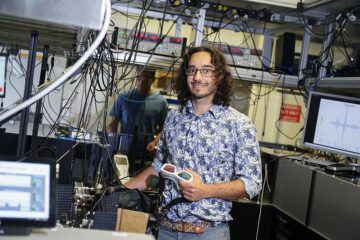SPR Biosensor systems

XanTec’s SPR biosensor program is currently undergoing some actualization. Below you will find general information about our SPR technology. In this section you will also find the details of the new systems as soon as they are available. If you are interested in information on the IBIS® series, which we do not offer anymore, please click here.
SPR: A powerful tool for real-time analysis of biomolecular interactions
The study and characterization of molecular interactions is essential to explore the structure-function relationships of biomolecules, aiding to our understanding of biological systems in life sciences. Surface Plasmon Resonance biosensors analyze macromolecular interactions in real-time and label-free. They thus provide scientists with a valuable tool for studies in the fields of immunology, molecular biology, cell biology and biochemistry. Using SPR biosensors, cell adhesion studies, quality control of immunoreagents, drug development and investigation of polymer- biomolecule interactions for biomaterial are speeded up several times compared to conventional techniques.
Listed below are some examples of biomolecular interactions which have been successfully studied using SPR:
-
Peptide/protein – protein
-
DNA/RNA – protein
-
protein – cell
-
receptor – cell
-
protein – virus/phage
-
carbohydrate – protein
-
carbohydrate – cell
-
liposome – protein
-
artificial materials – biological matter
-
drugs – protein
-
drugs – DNA/RNA.
In addition to biomolecular interaction studies, SPR sensors can be used to quantify adsorption and desorption processes in non-biological systems. One of these less known applications is the quick evaluation of new detergent formulations by real time analysis of dirt desorption from SPR sensor surfaces.
Sensitive optical detection
Our optical biosensors, which use Surface Plasmon Resonance (SPR), measure refractive index changes close to the interface of a sensor chip in real-time. Such changes occur when biomolecules interact with immobilized ligands and replace water from binding sites on the sensor surface. The refractive index differences are detected via angle changes of a reflected laser beam and are directly related to the amount of sensor surface-bound biomolecules. Using this sensitive technique, our SPR sensors are able to detect protein amounts below 10 pg / mm2. For more details on SPR please check the chapter "SPR principle" in our Tech Note section
Liquid handling systems
Liquid handling systems control the hydrodynamic conditions on the sensor surface, which is essential for the performance of a biosensor system. Generally, today’s liquid handling systems can be divided into two groups: flow through systems and cuvette systems. In flow through systems, fresh sample is continually flown over the sensor surface. This method has the advantage of well-defined hydrodynamic conditions during a measurement without rebinding during the dissociation phase. However, the continuous sample consumption limits the maximal association time and, once the sample has been injected, it is difficult to abort the measurement or to inject additional compounds. In cuvette systems, the sample is injected into a well on the sensor surface and is continually mixed during the measurement. This principle is flexible enough to allow multiple sample additions, and it is relatively easy to interrupt the experiment at any time. Moreover, it is possible to measure binding processes with a relatively small sample volume over a very long time or until equilibrium. The latter is especially useful for analytes with a low association constant. For our SPR biosensors flow through and cuvette systems are available. The user thus has the possibility to choose for each experiment the optimal liquid handling system.
Wide variety of sensor surfaces
The sensor surface is the central part of a biosensor. It is here where the biomolecular interaction takes place and where the biochemical binding event is transduced into an opto-electronic signal. Therefore the quality of the sensor surface determines the quality of the interaction plots. As different chemical structures of the immobilized biomolecules require adapted coupling strategies, we offer the market-wide biggest choice of SPR sensordiscs derivatized with various chemical and biochemical functionalities. These functional groups are either linked to planar surfaces or attached to grafted hydrogels which are available in different thicknesses.
Media Contact
Alle Nachrichten aus der Kategorie: Biowissenschaften Chemie
Der innovations-report bietet im Bereich der "Life Sciences" Berichte und Artikel über Anwendungen und wissenschaftliche Erkenntnisse der modernen Biologie, der Chemie und der Humanmedizin.
Unter anderem finden Sie Wissenswertes aus den Teilbereichen: Bakteriologie, Biochemie, Bionik, Bioinformatik, Biophysik, Biotechnologie, Genetik, Geobotanik, Humanbiologie, Meeresbiologie, Mikrobiologie, Molekularbiologie, Zellbiologie, Zoologie, Bioanorganische Chemie, Mikrochemie und Umweltchemie.
Neueste Beiträge

Neue universelle lichtbasierte Technik zur Kontrolle der Talpolarisation
Ein internationales Forscherteam berichtet in Nature über eine neue Methode, mit der zum ersten Mal die Talpolarisation in zentrosymmetrischen Bulk-Materialien auf eine nicht materialspezifische Weise erreicht wird. Diese „universelle Technik“…

Tumorzellen hebeln das Immunsystem früh aus
Neu entdeckter Mechanismus könnte Krebs-Immuntherapien deutlich verbessern. Tumore verhindern aktiv, dass sich Immunantworten durch sogenannte zytotoxische T-Zellen bilden, die den Krebs bekämpfen könnten. Wie das genau geschieht, beschreiben jetzt erstmals…

Immunzellen in den Startlöchern: „Allzeit bereit“ ist harte Arbeit
Wenn Krankheitserreger in den Körper eindringen, muss das Immunsystem sofort reagieren und eine Infektion verhindern oder eindämmen. Doch wie halten sich unsere Abwehrzellen bereit, wenn kein Angreifer in Sicht ist?…





















